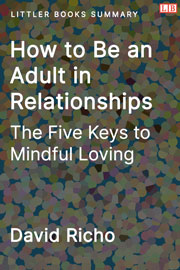Book Description
An exploration of the five hallmarks of love, offering practical advice to improve relationships.
If You Just Remember One Thing
Coming soon.
Bullet Point Summary and Quotes
- “Most people think of love as a feeling but love is not so much a feeling as a way of being present.”
- The five A's central to every loving relationship:
- Attention: listen mindfully to their motions, needs, and stories.
- Acceptance: acceptance of who you are and who they are with no need to hide parts of ourselves.
- Appreciation: value each other's strengths and limitations, and support each other's goals.
- Affection: show they're loved through hugs, kisses, smiles, etc.
- Allow: “allow life and love to be just as they are, with all their ecstasy and ache, without trying to take control.”
- “We feel loved when we receive attention, acceptance, appreciation, and affection, and when we are allowed the freedom to live in accord with our own deepest needs and wishes.”
- We are born with the capacity for healthy relationships, but childhood wounds often impair our ability to relate well as adults, requiring inner work to heal and develop relational skills. For most, this involves building a healthy ego foundation while letting go of the neurotic ego that is driven by fear, desire, and the need to control.
- Growing up with emotional deprivation and lack of the "five A's" in childhood can leave lasting scars that impact adult relationships. People from unhappy childhoods may tolerate abuse or recreate dysfunctional patterns, as they internalized feelings of being defective instead of recognizing their caregivers' failures.
- Healing requires grieving childhood wounds by sharing painful memories with a compassionate listener who can validate one's experiences, allowing healing to begin.
- “In healthy intimate relationships we do not seek more than 25% of our nurturance from a partner; we learn to find the rest within ourselves.”
- To work through issues, identify your negative thoughts and emotions, sit with them and explore them until
your feelings change about them or something deeper is revealed. Then, through mindfulness techniques like
meditation, let them go.
- To meditate, sit comfortably in a quiet space and focus on your breathing. When thoughts and feelings arise, notice them, accept them for what they are, and then return to focus on your breathing.
- Take care of and respect yourself first. Being content with oneself creates openness for the right person.
- “Once we love ourselves, people no longer look good to us unless they are good for us.”
- Make promises not to change yourself for others and be clear upfront about the level of commitment you want and the values you share.
- Relationships evolve through three phases: the initial romance, followed by a period of conflict, before ideally reaching a stage of deeper commitment. Understanding these natural cycles and working through the conflict stage with mutual effort allows couples to move beyond the fleeting passion of romance toward a more grounded, lasting bond.
- Our typical fears are engulfment (losing freedom by getting too close) and abandonment (emotional survival if partner leaves).
- Face fears by the "Triple-A" approach of admitting fears, allowing oneself to feel them without judgment, and acting as if you don't have that fear (e.g., being apart from your partner if you fear abandonment).
- Not facing your fears will allow them to control you.
- “We don't fear physical closeness because we fear proximity itself. Most of us earnestly want physical contact with those who love us. Rather we fear what we will feel when we get too close. The real fear, then, is of ourselves. This fear is not something to rebuke ourselves for. It is our deepest vulnerability, the very quality that makes us most lovable.”
- If partners focus on being right rather than making the relationship work, ego rules the relationship instead of cooperative love. The ego, which represents the individual self, is an obstacle to true intimacy which implies unity. In reality, there is no solid, separate self/ego -- we are all interconnected.
- “If you use sarcasm, ridicule, teasing, pinching, tickling, or barbed kidding at times, make a commitment to cease using these passive-aggressive weapons against your partner or anyone.”
- The impoverished ego (I'm powerless/it's someone else's fault/no one cares about me) feigns humility while the inflated ego (I'm right/perfect) feigns self-respect.
- The healthy ego shows authentic self-respect and unconditional love toward others. Loving unconditionally requires mindfully letting go of the ego's demands like fear, entitlement, and need for control.
- While ending a relationship is painful, struggling to keep an expired bond alive is ultimately more harmful than letting it go peacefully. Signs it may be time to move on include a lack of happiness, trust, sex, and inability to meet each other's needs for the "five A's" of love.
- The healthiest approach to end a relationship is to communicate reasons for parting ways, grieve the loss, and view the ending as an opportunity for personal growth rather than failure.
- Committing to a romantic partner by providing the "five A's" teaches us to extend that same loving energy towards other areas of life like work and friendships.
How to Be an Adult in Relationships: Resources
- Download this summary and 173+ other top nonfiction book summaries in one book (PDF, eBook, DOCX)
- Buy the book
